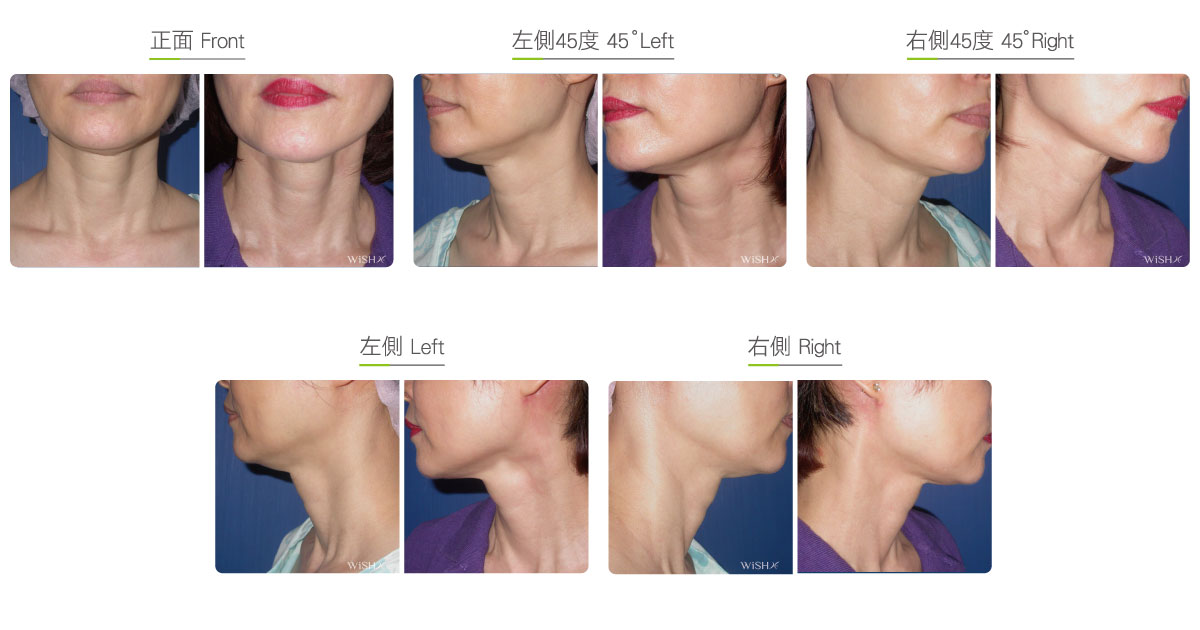Neck Lift
Neck skin laxity may result from three reasons. The most common reason is that facial aging and sagging compresses the neck, leading to skin laxity. This is generally reported in middle-aged and elderly patients. This surgery will combine both face and neck lift to obtain complete improvement. The second cause is congenital neck skin loosening or relatively deep cervical wrinkles, which are variations in skin structures, and is frequently seen in relatively young patients. It should also rely on neck skin suspension to effectively mitigate the depth or change the running course of the neck wrinkles. The third reason is neck skin sagging or double chin derived from facial bone surgery (such as mandibular or chin reduction), which could apply regional jawline lift to restore the tight skin elasticity and contour.
Based on the anatomical structures, the neck is the last barrier of the face. When the patients’ necks start to become loose, it indicates the already existent aging in other parts of the face. Thus, tightening of the neck skin and facelift should be considered or conducted at the same time. The surgical incision extends from the preauricular skin to the retroauricular hairline margin. Meanwhile, the neck skin and subcutaneous superficial fascia should first be separated and a part of fascia will be resected. Next, the superficial fascia is stretched in proper tension and sutured at the occipital deep fascia. This way, the jawline is tightened, and the perpendicular angle of the junction between the lateral chin and neck is sculpted. Then, the excess loosened skin is removed, and the wound is closed. If patients have a relatively fatty chin, liposuction can be conducted at the same time to make the cervical lines more prominent. As for some elderly patients who not only have an excessively loose chin and neck skin but also concurrent neck muscle limpness or detachment appearing like a turkey neck, an additional small incision must be made at the center of the chin for centralized suturing of the neck muscles, which, in combination with posterior lateral neck lift, will address muscle and skin aging.
If patients have genetic neck flabbiness or premature aging of the neck skin due to bone reduction, single neck lift may be considered. The surgical incision is made from the anterior earlobe to the retroauricular hairline margin, and subsequently, regional or limited subcutaneous dissection is performed. Meanwhile, the superficial fascia is suspended to the retroauricular occipital hairline by the lift thread and fixed on the deep fascia. Then, the excess neck skin is removed. Compared with combined facelift, this surgery involves a smaller area and offers faster recovery, which is suitable for young people for the early improvement of neck wrinkles or jawline concerns.
Surgical conditions
Duration
- Type of anesthesia: IV sedation + local anesthesia
- Type of incision: An S-shaped incision from the anterior area of the earlobe to the posterior hairline
- Recovery: 5–7 days
- Removal of sutures: 7–10 days
General instructions
No food and water on the day of surgery
Anticoagulants, if any, should be suspended for 1 week.
- Rubbing or pressing of the forehead and scalp incisions should be avoided for 1 month postoperatively.
- Smoking, alcohol consumption, or irritating food should be avoided for 1 month postoperatively.
- Scar care should be continued for 3 months postoperatively.
- Rigorous exercise of the neck should be avoided for 3 months postoperatively.
Ideal candidates
- Patients with lower cheek aging and concurrent neck skin flabbiness.
- Patients with congenital neck skin laxity or deep neck wrinkles.
- Patients with premature neck skin laxity due to prior facial bone reduction surgery.
Potential complications
- Scar hypertrophy
- Temporary numbness
- Hematoma
- Poor wound healing
- Temporary limited neck movement
Surgical advantages
-
Instant and obvious effect.
-
The result is comprehensive and long lasting when used in combination with facelift.
-
Single neck lift will also effectively improve neck wrinkles and chin angle.
-
No risk of nerve injury or major vessels; highly safe.
-
Surgical scars are hidden behind the ear.
Surgical drawbacks
-
If combined with facelift, the recovery period is relatively long.
-
There may be occasional subcutaneous hematoma or poor wound healing.
-
Retroauricular scars are likely to have proliferation due to friction.
-
Patients may show temporary limited neck movement.

